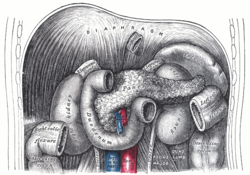Duodenum
Anatomy of the duodenum[edit | edit source]
The Duodenum (duodenum) is the horseshoe-shaped coiled initial part of the small intestine connected to the stomach. The length of the duodenum is between 20 and 28 cm and its diameter is 3.5 to 4.5 cm. Except for its beginning, the duodenum is fused to the posterior abdominal wall and secondarily covered by a parietal peritoneum.
The course of the duodenum is as follows:
- pars superior - starts from the pylorus as the ampulla (bulbus) duodeni, at the level of vertebrae L1, touches the liver from below (often also the gallbladder ), behind it v. portae, flexura duodeni superior - it bends between pars superior and pars descendens.
- pars descendens - descends on the right side of the L2 and L3 vertebrae, in front of the hilum of the right kidney, behind the pars descendens is the ductus choledochus, flexura duodeni inferior - bends at the right on the side of L3, through which the pars descendens passes in the pars horizontalis.
- pars horizontalis (inferior) - passes from right to left in front of the body of L3.
- pars ascendens - along the left side of the L2 vertebra obliquely to the left upwards, flexura duodenojejunalis - the duodenum passes forward in the jejunum.
The pancreas is inserted into the flexure of the duodenum. The a. et v. mesenterica superior run over the pars horizontalis duodeni. Horizontally, it goes over the duodenum mesocolon transversum. From the front, the duodenum is covered by the edge of the liver, the colon transversum and loops of the jejunum.
Duodenum projection[edit | edit source]
The duodenum projects onto the spine, where it conceptually wraps around the body of the L2 vertebra, and onto the front wall of the abdomen, where it can be seen in the vicinity of the navel (usually pars horizontalis duodeni).
Features of the duodenum[edit | edit source]
Syntopy of the duodenum Among the peculiarities of the duodenum are the villi, which are slightly flattened, rather leaf-shaped, and tend to be the densest in the duodenum. Furthermore, there are the so-called glandulae duodenales Brunneri' (Brünner's glands), which are tuboalveolar, mainly in the tela submucosa, they produce mucus of alkaline reactions, which protects the mucous membrane from the acidic gastric juice and adjusts pH for the action of pancreatic enzymes. Plica longitudinalis duodeni is a longitudinal fold mucosa, in the pars descendens you can find 2 raised papillae on it: papilla duodeni major (Vateri)' - mouth of ductus pancreaticus and choledochus duct. A cavity in the papilla duodeni major connects both ducts and is called the ampulla hepatopancreatica. The second papilla is the so-called 'papilla duodeni minor (Santorini)', which is located 2 cm more cranially and is the mouth of the ductus pancreaticus accessorius.
Vessels and nerves of the duodenum[edit | edit source]
Arteries and Veins[edit | edit source]
- truncus coeliacus → a. hepatica comm. → a. gastroduodenalis → a. pancreaticoduodenalis superior
- a. mesenterica superior → a. pancreaticoduodenalis inferior
- aa. retroduodenales
- veins of the same name → v. portae (v. gastroepiploica dextra)
Disappearing vessels[edit | edit source]
Lymphatic vessels from the upper half of the duodenum lead to the nodi lymphatici pylorici and nodi lymphatici hepatici, in some cases even directly to the nodi lymphatici coeliaci. From the lower half of the duodenum they lead to the nodi lymphatici mesenterici superiores
Nerves of the duodenum[edit | edit source]
Parasympathetic nerve fibers come from the vagus nerve, end at cells of other neurons - in the ganglion coeliacum or in the wall of the duodenum Sympathetic nerve fibers come as 2nd neurons from the ganglia coeliaca and from the ganglion mesentericum superior, on the way they issue the plexus coeliacus and the plexus mesentericus superior to the wall of the duodenum.
Links[edit | edit source]
Related Articles[edit | edit source]
External links[edit | edit source]
References[edit | edit source]
- ČIHÁK, Radomír – GRIM, Miloš. Anatomy. 2. upr. a dopl edition. Grada Publishing, 2002. 470 pp. vol. 2. ISBN 80-247-0143-X.


